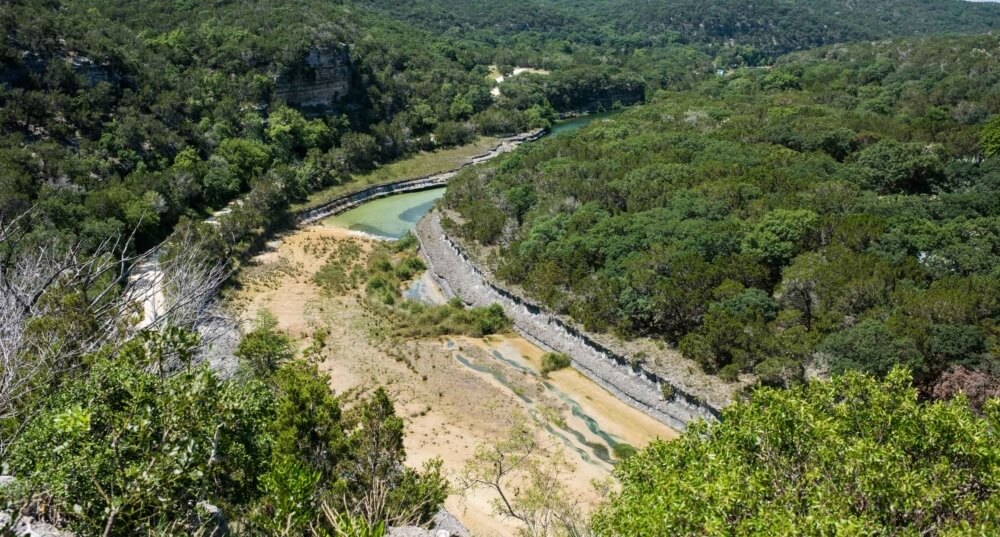
In 2014, David and Deborah Rogers said, “Fifty years from now, we want the Foundation camp property to be even healthier and more beautiful than it is today.”
Three years later, the Property Planning & Stewardship team completed its first-ever comprehensive Land Stewardship Plan to support diverse, balanced, robust, and native animal and plant life in the Frio River Canyon. Their ongoing efforts offer a model to guests of the Canyon as they return home and practice stewardship in their own corner of the world.
Property Planning & Stewardship Director Trey Tull and Assistant Director Kevin Wessels are leading the project and emphasized that the baseline data captured over the last few years show that the health of the Canyon is generally very good despite the need for some specific restorative interventions over and above the Foundation’s ongoing care.
“The Butt family has had a strong stewardship ethic for a long time,” said Tull, “but the science has changed, and our operations have changed. We needed to take a fresh look at how we were doing things, and I’m so grateful that we are starting from a good place because of the family’s vision.”
Based on the Land Stewardship Plan’s recommendations, the team is already implementing one-time and ongoing conservation protocols that will help restore balance to the Canyon. Most of the plan’s non-recurring recommendations will be complete by 2021.
“Every expert we bring out is really amazed at the property,” Wessels said. “It can be easy to take the Canyon for granted, but it has plants and animals that aren’t found in many other places. Even though the land is out of balance, it still holds tremendous diversity and rare habitats. Our world is so full of unhealthy systems—after this plan is implemented, the Canyon will present a clearer picture of what a native, robust, diverse, healthy system looks like.”
The current natural environment of the Frio Canyon requires active conservation and intervention to restore balance. The Foundation cares for 1,885 acres contained within its perimeter fence—land that’s divided into three very different zones: 130 acres of developed land (7%) including buildings, roads, and manicured landscaping where programming needs take priority; 42 acres of water (2%) including Frio River, Silver Creek, and eight dammed lakes; and 1,713 acres of wildlands and trails (91%) that will remain natural and undeveloped—roughly 74% cedar brake, 24% grassland savannah, and 2% riparian.
The goal of the Land Stewardship Plan is to manage the Canyon property so that the living things, its animal and plant communities, are diverse, balanced, robust, and native. This will ensure that guests have the opportunity to experience God’s creation for many years to come.
The Foundation has established baseline metrics and will continually monitor land health, managing native and exotic deer species using accepted, science-based methods while we protect and enhance habitats for rare, threatened, and endangered plant and animal species. The Foundation published a visual guide to invasive species for Canyon employees, and staffers work alongside landscape architects to ensure new plantings are native.
As we foster plant diversity and control cedar, we will protect existing hardwood trees on the property and encourage natural regrowth. Critical to this endeavor are the ongoing efforts to control non-native and exotic plant and animal species on the property and efforts to remove unnecessary man-made scars from wildland areas as we restore these places to their most natural state.
The 2017 Land Stewardship Plan is the first in a three-volume series— the team has drafted a Water Stewardship Plan that is being implemented in 2018. “The water system in the Frio River Canyon tends toward balance on its own,” Wessels said, “so it doesn’t need as much active management as the land.” Wessels and Tull are also busy researching and developing a third plan—an Environmental Stewardship Plan that looks beyond behaviors that directly affect the health of the Canyon, examining behaviors that serve the broader world outside the Canyon. “If we recycle,” Tull explained, “it may not help a porcupine in Silver Creek.” But it is still the right thing to do.